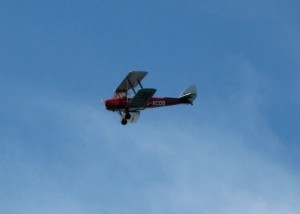
– Photo by Jan Ketchel
As we drove past the Rhinebeck Aerodrome in the midst of a dogfight in the sky, a golden retriever with leash dragging scurried toward our car. I stopped, opened the car door, and the dog immediately leaped in and planted itself on my lap.
I could feel the dog’s terror and need for safety. He was at home with us and would have moved forward in life from that moment, never leaving our safety, never looking back. We diligently went in search of it’s owner and eventually discovered his whereabouts. He was deeply engrossed in the planes in the sky, with no consideration of his dog’s terror of loud noises. The dog was so planted in our car, clinging for dear life, that I ultimately and sadly had to lift its frozen statue frame from the car to send it back on its journey. We watched as it was led away, slunk low to the ground, peering to the right and to the left, seeking safety once again as the bombs went off overhead.
Domesticated animals are ultimately dependent on their “owners” for their safety and survival. This is the contract they make in domesticated form. Though their instincts are fully available to protect them, their survival is largely delegated to their owner.
Humans, in contrast, are charged with taking adult responsibility for achieving safety for themselves in this life. Many humans reach adulthood unable to fully achieve individual internal security due to lapses in milestones of emotional maturity, caused by trauma or compromised parents. The legacy of these lapses is a physically mature but emotionally insecure adult who anxiously seeks relationship attachments outside the self to feel safe.
These kinds of relationships may feel powerfully necessary for survival and the threat of losing them generates states of anxiety and panic similar to that of the golden retriever that anxiously attached to us and the safety of our car. Relationships driven by such anxious attachment often start off with intense love feelings—finally feeling “home”—but generally degenerate into worry, panic, and fear of abandonment.
Relationships at this level are often frozen at the level of dependency, control, and fear, leaving little opportunity for adult companionship and relatedness. This is inherent in the relationship’s initial underlying intent: safety. Until safety can be found within the self, relationships will be controlled by an over-dependency on the other person’s behavior as the locus of control for inner safety.
We must become the parent to our inner panicking child. If we allow the child’s anxiety to control our decision making and actions, we are sure to engage in external parenting relationships as we allow the child in us to go in search of a secure person to latch onto, just like the dog that leapt into our car. Our adult self must be in charge of decision making and self care. If our child self is frightened it might be time to pick it up and go for a soothing walk alone rather than desperately seek inappropriate attention elsewhere.

– Photo by Chuck Ketchel
Eventually, the child will discover that the adult self is its one true parent, the one that can take charge of decisions for the whole personality, leading it to safety, play, and fulfillment. From this place, with the locus of control coming from a place of deep inner safety, relationships may be engaged in as adult partnerships, with everyone responsible for their own inner parenting.
Self care at the deepest level is the only adult ticket to true inner safety. Inner safety leads to outer blossoming and allows for flourishing in true adult relationship.
Embracing inner safety,
Chuck
